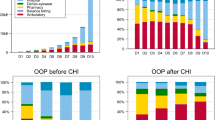Abstract
Regulatory costs are paid by individuals, which leaves them with less disposable income. Since individuals on average use additional income to make their lives safer and healthier, the regulatory costs lead to higher mortality risks and fatalities. Based on data from the National Longitudinal Mortality Study relating income to the risk of dying, approximately each $5 million of regulatory cost induces a fatality if costs are borne equally among the public. If costs are borne proportional to income, approximately $11.5 million in regulatory costs induces a fatality. Cost-induced fatalities disproportionally burden the poor and minorities, particularly blacks.
Similar content being viewed by others
References
Baquet, C. R., J. W. Horm, T. Gibbs, and P. Greenvald. (1991). “Socioeconomic Factors and Cancer Incidence Among Blacks and Whites,” Science 83, 551–557.
Bureau of the Census. (1993). Statistical Abstract of the United States, 1993. Washington, DC: U.S. Department of Commerce.
Chapman, K. S., and G. Hariharan. (1994). “Controlling for Causality in the Link from Income to Mortality,” Journal of Risk and Uncertainty 8, 85–93.
Duleep, H. O. (1986a). “Incorporating Longitudinal Aspects into Mortality Research Using Social Security Administrative Record Data,” Journal of Economic and Social Measurement 14, 121–133.
Duleep, H. O. (1986b). “Measuring the Effect of Income on Adult Mortality Using Longitudinal Administrative Record Data,” The Journal of Human Resources 21, 238–251.
Duleep, H. O. (1989). “Measuring Socioeconomic Mortality Differentials Over Time,” Demography 26, 345–351.
Frerichs, R. R., J. M. Chapman, P. Nourjah, and E. F. Maes. (1984). “Cardiovascular Diseases in Los Angeles, 1979- 1981,” American Heart Association-Greater Los Angeles Affiliate, Inc., Los Angeles, California.
Graham, J. D., B. Hung-Chang, and J. S. Evans. (1992). “Poorer Is Riskier,” Risk Analysis 12, 333–337.
Keeney, R. L. (1990). “Mortality Risks Induced by Economic Expenditures,” Risk Analysis 10, 147–159.
Keeney, R. L. (1994). “Mortality Risks Induced by the Costs of Regulations,” Journal of Risk and Uncertainty 8, 95–110.
Kitagawa, E. M., and P. M. Hauser. (1973). Differential Mortality in the United States of America: A Study of Socioeconomic Epidemiology Cambridge, MA: Harvard University Press.
Lave, L. B. (1981). The Strategy of Social Regulation. Washington, DC: Brookings Institution.
Lutter, R., and J. F. Morrall. (1994). “Health-Health Analysis: A New Way to Evaluate Health and Safety Regulation,” Journal of Risk and Uncertainty 8, 43–66.
Lutter, R., J. F. Morrall, and W. K. Viscusi. (1996). “Risky Behavior and the Income-Mortality Relationship.” Unpublished Working Paper.
Morrall, J. F. (1986). “A Review of the Record,” Regulation 10, 25–34.
Pappas, G., S. Queen, W. Hadden, and G. Fisher. (1993). “The Increasing Disparity in Mortality Between Socioeconomic Groups in the United States, 1960 and 1986,” The New England Journal of Medicine 329, 103–109.
Rogot, E., P. D. Sorlie, N. J. Johnson and C. A. Schmitt. (1992). A Mortality Study of 1.3 Million Persons by Demographic, Social, and Economic Factors: 1979- 1985 Follow-Up. National Institutes of Health, Publication No. 92-3297, Bethesda, Maryland.
Sinsheimer, P. (1991). “The Risks of Economic Modeling Before Establishing the Causal Inference,” Risk Analysis 11, 187–188.
Sorlie, P. D., E. Rogot, R. Anderson, N. J. Johnson, and E. Backlund. (1992). “Black-White Mortality Differences by Family Income,” The Lancet 340, 346–350.
Tengs, T. O., M. E. Adams, J. S. Pliskin, D. G. Safran, J. E. Siegel, M. C. Weinstein, and J. D. Graham. (1995). ”Five Hundred Life-Saving Interventions and Their Cost-Effectiveness,” Risk Analysis 15, 369–390.
Viscusi, W. K. (1994). “Mortality Effects of Regulatory Costs and Policy Evaluation Criteria,” Rand Journal of Economics 25, 94–109.
Wildavsky, A. (1979). “No Risk Is the Highest Risk of All,” American Scientist 67, 32–37.
Wildavsky, A. (1980). “Richer Is Safer,” The Public Interest 60, 23–39.
Williams, D. R. (1990). “Socioeconomic Differentials in Health: A Review and Redirection,” Social Psychology Quarterly 53, 81–99.
Williams, Judge. (1991). UAW v. OSHA, U.S. Court of Appeals, Washington, DC.
Zeckhauser, R. J., and W. K. Viscusi. (1990). “Risk Within Reason,” Science 248, 559–564.
Author information
Authors and Affiliations
Rights and permissions
About this article
Cite this article
Keeney, R. Estimating Fatalities Induced by the Economic Costs of Regulations. Journal of Risk and Uncertainty 14, 5–23 (1997). https://doi.org/10.1023/A:1007754402585
Issue Date:
DOI: https://doi.org/10.1023/A:1007754402585




